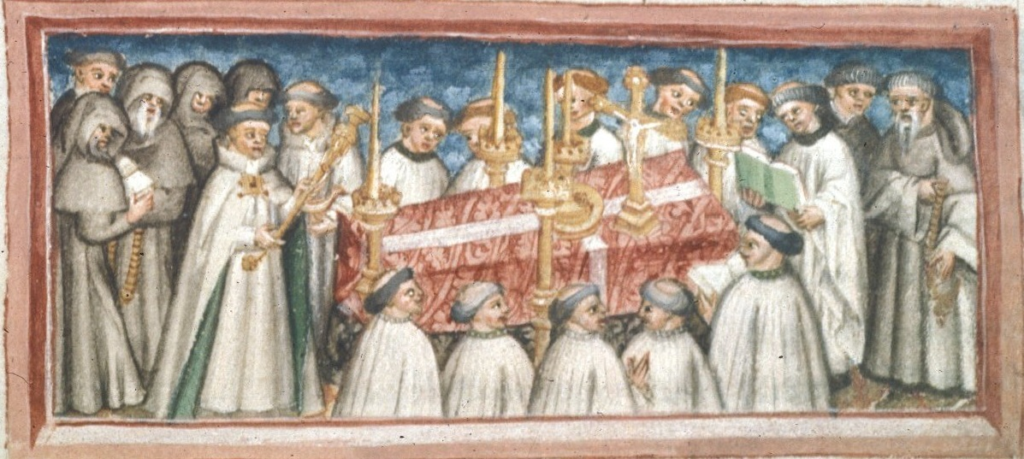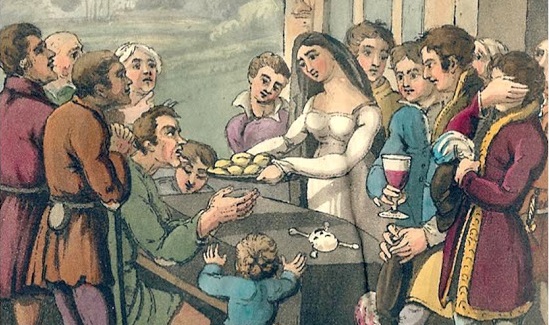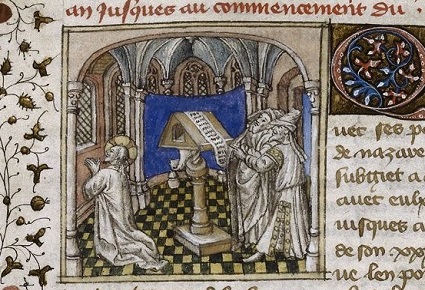Commemorations for the dead were a staple of life in medieval Christendom. Even though commemoration of the dead continues within modern Catholicism in the form of requiem Masses, indulgences, prayers, and works on behalf of the deceased, a study of late medieval commemorative practices will make clear how much we have lost. In this essay we will travel to medieval England to examine how the dead were commemorated in the centuries before the Reformation, from around 1350 to 1520. Thought this essay focuses on England, we may presume the similar parallels throughout western Europe.
The Commemorative “Obit”
Typically, the details on how post-mortem commemorations were to be enacted were found in the wills of the deceased. Such commemorations were known as obits, and could encompass a variety of activities. From the 14th century until the Reformation, the administration of obits were documented in the records of the parish churchwarden, a lay person elected from amongst the laity to represent their interests and take responsibility for the provisioning of the church (fabrics, candles, etc.). Churchwardens also maintained accounts of obits for the deceased, which were typically carried out on the anniversary of death—but often more frequently, as we shall see.
Who carried out the obits? Most commonly, wills requested the administration of these commemorative rites by family members, executors (usually family members, but also prominent men in the parish), or the churchwardens themselves. These would be in charge of arranging Masses and other commemorative events. For example, in 1416, Sir Thomas de Skelton of Hinxton’s will stipulated that churchwardens were to arrange a Mass to be said on the anniversary of his death for twenty years. In order to fund this, he left the local parish a tenement in town from which to pay for the Masses out of the rents; he also asked the parish to distribute 40 pence to the poor on the death anniversaries of each of his three wives, as well. (1)
Corporate bodies usually administered obits on behalf of their members: guilds for their members, colleges for their students and faculty, town councils for their members, and various confraternities for their participants.
Since obits obviously needed to be funded, the extent of the commemorations were linked to status and wealth. These class divisions extended even to commemorative aspects that did not have a financial component; for example, how many times the parish bell was rung to announce a death, where the duration of tolls informed the hearers of the social status of the deceased. For example in Norwich at the time:
Notice is given of the death of such a person by the great bell of the parish where the deceased dwelt and died…continued a greater or lesser time according to the estate and reputation of the deceased: for persons of note, half an hour or more; for poor persons, only a short time. Also less for children than for men or women…the bell thus ringing is by some called a ‘soul bell.’ (2)
This practice was considered “superstitious” by the Protestants, prompting the wholescale removal of church bells under Edward VI when government officials found parishes were too slow to give up the custom.
How often did the deceased make specific requests about their obits, as we saw in the case of Sir Thomas de Skelton? A survey of 2,000 from the eve of the Reformation (1530) found that 2/3 requested prayers for their soul. (3) Of those who did, 57% made specific requests for certain commemorations, many of which were entrusted to their executors. (4)
Most wills began with a standard bequest of a few pennies to a charitable cause, guild, or association, for example, for the succor of the poor. These, too, were meant to redound to the benefit of the deceased, as it was assumed the recipients of charity would return the favor by praying for the soul of the dead benefactor. Funds would also be left to the parish to pay for the costs of burial. This usually took the form of payments to the various brotherhoods or confraternities that arranged such things: to the brethren of the churchyard for burial, to “bells and torches” for their use at the funeral, to “lights” for votive candles, and so on. It was also common for the deceased to include sums for “forgotten tithes” to ensure whatever debts were due the Church were settled. Bequests were also left to clergy, both regular and secular, invoking their prayers.

Chantry Endowments
Long term endowments for commemorative masses were known a chantries; a wealthy individual might endow a perpetual chantry, intended to fund commemorative Masses in perpetuity. Chantries might be funded by an extremely large donative given at death, but more common was the bequest of rent-bearing property to the church. Early chantries were typically administered by monasteries, who either celebrated Masses within their monastery or else provided a chaplain to say Mass in the parish church of the deceased. Depending on the size of the endowment, this could be a fulltime occupation: in the town of Barton, Cambridgeshire, the parish from 1278 hosted two Augustinian canons on perpetual loan from nearby Barnwell Priory who continually said Masses for their deceased benefactors. (5) After the Black Death, this responsibility had shifted to other corporate bodies: guilds, fraternities, parishes, or townships were responsible for managing chantries and organizing Masses. Perpetual chantries were expensive, typically available only to the very wealthy. These chantries might involve the construction of a special “chantry chapel” dedicated to commemorative Masses. Furthermore, because perpetual chantries generally involved some kind of land bequest to a parish or monastery, they required a mortmain license, which authorities granted grudgingly as it removed taxable property from their rolls. One Henry Cyprian of Whittlesford endowed a perpetual chantry but failed to obtain a mortmain license; the property reverted to control of the township and was put to other use. (6)
How long were typically chantry endowments? A survey of 254 wills of Canterbury reveals that only 5% funded “perpetual” commemoration; 15% requested the saying of Masses for between two and twenty years; 18% for one year. These numbers reflect daily Masses funded by the middle class, where 8 marks a year were set aside for Masses to be said daily for the set number of years. Persons of lower class preferred to fund Masses only on the anniversary of their death: 13% of the Canterbury wills stipulated an anniversary obit for a fixed number of years.
Obviously even the most well-funded perpetual chantries would eventually fall into abeyance the further away they got from the date of their foundation. If a chantry founder was forgotten—i.e., there was no one left living who remembered the founder or was actively involved in promoting his memory—the chantry would be dissolved, and any income bearing assets transferred elsewhere.
Other Types of Commemorative Obits
Most people could not afford a chantry endowment. Common people had to be content with the requiem Mass said at their funeral, as well as the prayers of their friends. Even commoners, however, tried to set aside a certain amount to be spent on a funeral dole; this was food and drink reserved for the poor, who were invited to the funeral and fed in exchange for their prayers. Those who had saved a modest sum might provide for a trental, a set of thirty Masses said for the deceased shortly after death. These short-term bequests were administered by the same groups who administered chantries: churchwardens, guilds, family, and executors. For the poorest of the poor, they were remembered by the wealthy, who typically made provision in their wills for prayers for “all Christian souls” in addition to those to be specifically commemorated.
Because these short-term obit commemorations were not as cumbersome as long-term chantries, they proved tremendously popular in the latter Middle Ages. In Virginia Bainbridge’s study of country guilds in late medieval England, she observes that the “numbers and diversity of commemorative practices attest not only to the vitality of pre-Reformation Catholicism, but also to the resources available to comfort medieval men and women facing bereavement.” (7)
Comfort for the Bereaved
Bainbridge highlights another important aspect of the medieval obit commemoration, namely, providing comfort to the bereaved friends and family. The ritual surrounding death was drawn out over several stages. There was the funeral Mass, followed immediately by a vigil; then there was the commemorative Vespers known as the placebo (from the prayer “I will please the Lord”), the Matins for the dead the dirige (from the prayer, Dirige, Domine, Deus meus, in conspectu tuo viam meam; “Direct, O Lord my God, my steps in your sight”); this was followed by another Mass and then burial. The burial was followed by commemorative rituals (Masses, if they were funded) on the third, seventh, and thirtieth days after death, as well as on the first anniversary. These dates were all seen as milestones in the passage of grief, meant to not only aid the souls of the dead in their journey to heaven, but to comfort the living, facilitating a gradual letting go of the deceased while standing as a affirmation of continuing affinity.
A powerful symbol of this affinity is the funeral dole, the sharing of food provided by the dead at their funeral or commemorative obit. Wills often stipulated that bread, cheese, ale, and herring be left behind for a feast, sometimes specifically for the benefit of the poor. Because they were on the margins of society, the poor were meant to symbolically represent the dead at a feast.

These feasts did not just occur at the funeral, but could continue on the anniversaries of the testator for a fixed number of years. Sometimes the deceased funded these feasts in creative ways, such as “obit cows” and “obit lands.” Obit cows were cows hired out as milk beasts or breeding cattle to the poor; lands were rented to whomever could afford them—the revenues of each were used to fund obits. Most rural communities in medieval England featured obit lands and obit cows administered by a churchwarden, gild, or town council. The deceased might also bequeath stores of grain to the church. This grain would be brewed periodically at “church ales,” which functioned as parish fundraisers. The commemoration of the dead and their gifts to the living were interwoven with the life of the community and parish.
The End of Commemorations for the Dead
The practices we have been describing henceforth continued in England right up to the Reformation, and in some cases, for a few decades into it. By 1558 almost all these exercised of medieval piety had disappeared.
Purgatory came under intense scrutiny by Protestant authors in the 1520s. Beginning in the 1530s, royal courts (and local courts dominated by Protestants) enacted legislation to prevent the establishment of new perpetual chantries. (8) Henry VIII came out against Purgatory in a 1536 declaration, and within four years all of the institutions that existed for commemorative obits, prayers, trentals, and other Masses had all disappeared. This included friaries and chantry chapels dedicated to these purposes. A 1547 law struck out against other commemorative groups: guilds, chantries, hospitals, colleges, and any organization that had made commemoration of the dead part of its corporate fabric.
These political changes are reflected in wills from the period. From the late 1530s on, monetary bequests for prayers, Masses, anniversaries, and obits entrusted to public bodies (guilds or parishes) declined considerably, in preference for bequests to family or private executors. The implication is that the testators feared a royal confiscation of the assets of guild and parish and wanted to keep their bequests out of royal hands. This reflects the profound uncertainty of the common folk of how the religious landscape was changing; by the mid-1540s, testators requesting specific commemorative arrangements were apt to include the clause “only if it be lawful.” (9). Even these conditional arrangements vanished during the reign of Edward VI.
The only continuity to survive into the 1550s was bequests for the poor, although these underwent transformation as well. The anniversary dole to the poor was shifted from the testator’s date of death to Lent or Easter and associated instead with Christ’s death. Even so, wills from this time reveal that, though the doles continued to be made, they omitted any reference of prayers for the dead—though presumably with the implicit hope that recipients still held to the old beliefs and would make the expected prayers for the benefactor’s soul. This connection, however, was soon severed by the erection of the “Poor Man’s Box” in the parish, which increasingly received donations to the poor after the 1550s. Protestantism anonymized charitable giving to the poor by filtering through the parish, sundering the direct, personal link between the deceased benefactor and the poor.
During the reign of Elizabeth, all bodies, except the family, that administered commemorative practices had either been secularized, dissolved, or simply ceased to exist.
(1) Virginia Bainbridge, Gilds in the Medieval Countryside (Boydell Press: Rochester, NY, 1996), 92
(2) W. Rye, “The Order of Funerals, Ringings, etc. at Norwich,” The East Anglian, N&Q, No. 2, 1887, pp. 389-392
(3) J. Scarisbrick, The Reformation and the English People, (Oxford University Press: Oxford, 1984), pp. 5-6
(4) Bainbridge, 93
(5) Ibid., 94
(6) Ibid.
(7) Ibid., 95
(8) Alan Kreider, English Chantries: The Road to Dissolution (Harvard University Press: Cambridge, MA., 1979), pp. 84-85
(9) Bainbridge, 96
Phillip Campbell, “Piety for the Dead in Merry England,” Unam Sanctam Catholicam, July 17, 2022. Available online at: https://unamsanctamcatholicam.com/2022/07/17/piety-for-the-dead-in-merry-england/

